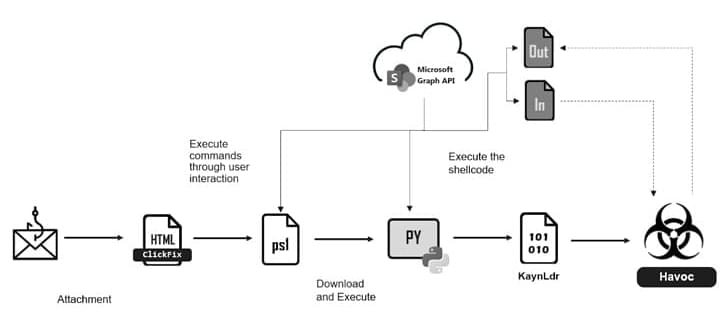JavaGhost exploits AWS misconfigurations to run phishing campaigns via SES and WorkMail, evading email protections.



The next step involves fetching and executing a Python script from the same SharePoint location that serves as a shellcode loader for KaynLdr, a reflective loader written in C and ASM that’s capable of launching an embedded DLL, in this the Havoc Demon agent on the infected host.
“The threat actor uses Havoc in conjunction with the MicrosoQ Graph API to conceal C2 communication within well-known services,” Fortinet said, adding the framework supports features to gather information, perform file operations, as well as carry out command and payload execution, token manipulation, and Kerberos attacks.
The development comes as Malwarebytes revealed that threat actors are continuing to exploit a known loophole in Google Ads policies to target PayPal customers with bogus ads served via advertiser accounts that may have been compromised.
You can donate via our website:
https://www.rejuvenescimento.org/
Harold Katcher’s book:
The Guardian article:
https://www.theguardian.com/science/2023/feb/08/anti-ageing-…ng-lab-rat.
Katcher’s scientific articles:
https://link.springer.com/article/10.1007/s11357-023-00980-6
https://www.biorxiv.org/content/10.1101/2020.05.07.082917v1.full.
ICR’s scientific article:
https://www.biorxiv.org/content/10.1101/2024.11.28.625646v1.full.
Phase transitions are a familiar part of life, representing predictable paths by which solids turn to liquids, mixtures turn to solutions, magnets become nonmagnetic. Temperature plays a central role in driving many phase transitions, however there are others that don’t depend on temperature at all—such as instabilities in social networks, bird flocking, and even the process of visual recognition in humans. Phase transitions represent change that impacts all length scales from the tiniest to the global, becoming permanent on time scales from the shortest to the longest. Most enigmatic are phase transitions that happen only at zero temperature, driven by the intrinsic quantum mechanical nature of matter. How are these quantum phase transitions different from temperature driven phase transitions? What are the different phases that can be explored by quantum systems at zero temperature? Living as we do at nonzero temperature, can we experience quantum phenomena that occur at zero temperature? Phase transitions and the ways in which they pattern space and time are at the heart of our developing understanding of quantum matter.
Meigan Aronson is an experimental condensed matter physicist whose research centers on the discovery and exploration of quantum materials. She received her undergraduate degree from Bryn Mawr College, and her PhD in Physics from the University of Illinois at Urbana-Champaign. After a postdoc at Los Alamos National Laboratory, she enjoyed faculty positions at the University of Michigan and at Stony Brook University, where she was also a group leader at Brookhaven National Laboratory. Her research uses neutron scattering to study the emergence of new phases of matter, especially novel types of order that are only found near quantum phase transitions. She is a Fellow of the American Physical Society and the Neutron Scattering Society of America, and has received the Department of Defense National Security Science and Engineering Fellowship. She is currently a Professor in the Department of Physics and Astronomy and a Principal Investigator at the Stewart Blusson Quantum Matter Institute at The University of British Columbia, where she also served as Dean of the Faculty of Science.
This public lecture was recorded at Aspen Center for Physics on Wednesday, February 26, 2025. Thank you to the Nick and Maggie DeWolf Foundation for making our winter lecture series possible since 1985.
#quantumphasetransitions #spin #quantummechanics #neutronscattering #quantumphases #physics
From connectome to computation:
predicting neural function with machine learning.
Janne Lappalainen.
University of Tubingen & Tubingen AI Center.
Presentation and Q&A
At the Carboncopies Foundation February 2025 workshop:
The brain emulation challenge: functionalizing brain data, ground-truthing and the role of artificial data in advancing neuroscience.
*This video was recorded at Foresight’s Whole Brain Emulation Workshop 2023.*
https://foresight.org/whole-brain-emulation-workshop-2023/
*Niccolò Zanichelli, Università degli Studi di Parma*
What can AI do for Whole Brain Emulation.
https://www.linkedin.com/in/niccol%C3%B2-zanichelli-99a7881a3/
WBE is a potential technology to generate software intelligence that is human-aligned simply by being based directly on human brains. Generally past discussions have assumed a fairly long timeline to WBE, while past AGI timelines had broad uncertainty. There were also concerns that the neuroscience of WBE might boost AGI capability development without helping safety, although no consensus did develop. Recently many people have updated their AGI timelines towards earlier development, raising safety concerns. That has led some people to consider whether WBE development could be significantly speeded up, producing a differential technology development re-ordering of technology arrival that might lessen the risk of unaligned AGI by the presence of aligned software intelligence.
Whether this is a viable strategy depends on.
(1) AGI timelines not being ultra-short.
(2) whether WBE development can be speeded up significantly by a concerted effort, (3) this speedup doesn’t introduce other risks or ethical concerns.
The goals of this workshop is to try to.
(A) review the current state of the art in WBE related technology.
(B) outline plausible development paths and necessary steps for full WBE
© determine whether there is potential for speeding up WBE development.
(D) whether there are strategic, risk or ethical issues speaking against this.
This two-day event invites leading researchers, entrepreneurs, and funders to drive progress. Explore new opportunities, form lasting collaborations, and join us in driving cooperation toward shared long-term goals. Including mentorship hours, breakouts, and speaker & sponsor gathering.
Dr. Philip Shiu.
EON Systems.
Presentation and Q&A
At the Carboncopies Foundation February 2025 workshop:
The brain emulation challenge: functionalizing brain data, ground-truthing and the role of artificial data in advancing neuroscience.
Unravel the mysteries of the human brain with this captivating video! Discover the incredible complexity of neurons, explore the quest for a connectome, and dive into the challenges and potential breakthroughs in understanding the human mind.

“A good ratio of oxygen to methane is key to combustion,” said Justin Long.
Can methane flare burners be advanced to produce less methane? This is what a recent study published in Industrial & Engineering Chemistry Research hopes to address as a team of researchers from the University of Michigan (U-M) and the Southwest Research Institute (SwRI) developed a methane flare burner with increased combustion stability and efficiency compared to traditional methane flare burners. This study has the potential to develop more environmentally friendly burners to combat human-caused climate change, specifically since methane is a far larger contributor to climate change than carbon dioxide.
For the study, the researchers used a combination of machine learning and novel manufacturing methods to test several designs of a methane flare burner that incorporates crosswinds to simulate real-world environments. The burner design includes splitting the methane flow in three directions while enabling oxygen flow from crosswinds to mix with the methane, enabling a much cleaner combustion. In the end, the researchers found that their design achieves 98 percent combustion efficiency, meaning it produces 98 percent less methane than traditional burners.
“A good ratio of oxygen to methane is key to combustion,” said Justin Long, who is a Senior Research Engineer at SwRI. “The surrounding air needs to be captured and incorporated to mix with the methane, but too much can dilute it. U-M researchers conducted a lot of computational fluid dynamics work to find a design with an optimal air-methane balance, even when subjected to high-crosswind conditions.”

Georg Ferdinand Ludwig Philipp Cantor (/ ˈ k æ n t ɔːr / KAN-tor; German: ; 3 March [O.S. 19 February] 1845 – 6 January 1918 [ 1 ] ) was a mathematician who played a pivotal role in the creation of set theory, which has become a fundamental theory in mathematics. Cantor established the importance of one-to-one correspondence between the members of two sets, defined infinite and well-ordered sets, and proved that the real numbers are more numerous than the natural numbers. Cantor’s method of proof of this theorem implies the existence of an infinity of infinities. He defined the cardinal and ordinal numbers and their arithmetic. Cantor’s work is of great philosophical interest, a fact he was well aware of. [ 2 ]
Originally, Cantor’s theory of transfinite numbers was regarded as counter-intuitive – even shocking. This caused it to encounter resistance from mathematical contemporaries such as Leopold Kronecker and Henri Poincaré [ 3 ] and later from Hermann Weyl and L. E. J. Brouwer, while Ludwig Wittgenstein raised philosophical objections; see Controversy over Cantor’s theory. Cantor, a devout Lutheran Christian, [ 4 ] believed the theory had been communicated to him by God. [ 5 ] Some Christian theologians (particularly neo-Scholastics) saw Cantor’s work as a challenge to the uniqueness of the absolute infinity in the nature of God [ 6 ] – on one occasion equating the theory of transfinite numbers with pantheism [ 7 ] – a proposition that Cantor vigorously rejected.